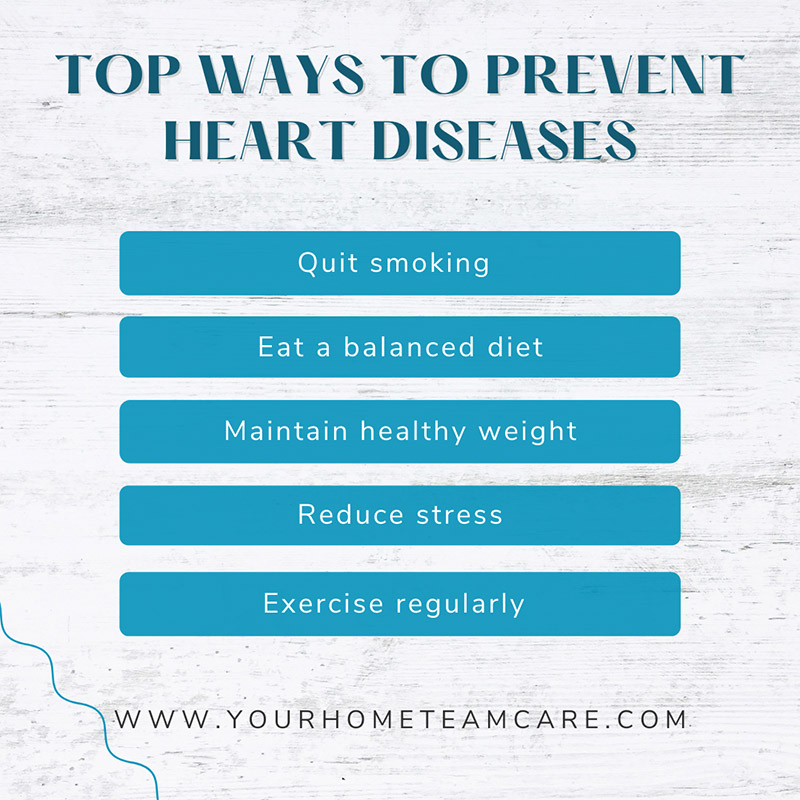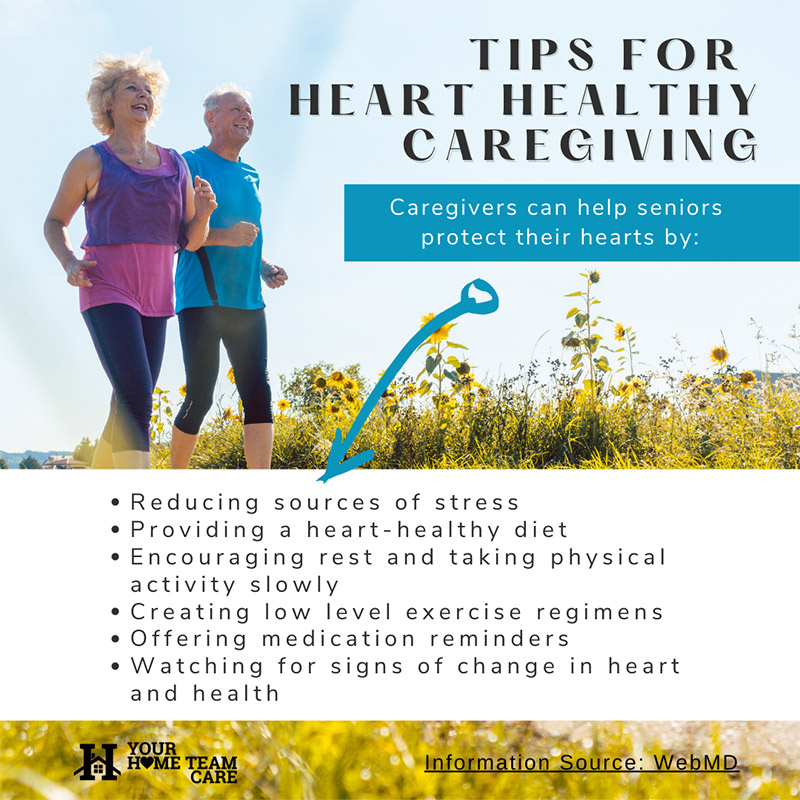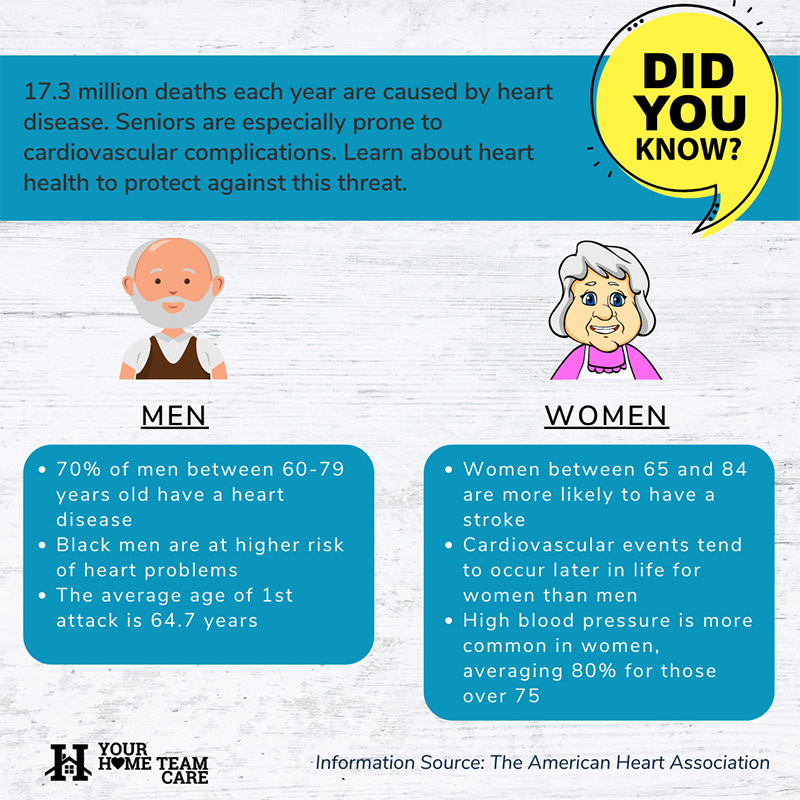Did you know that people who have close relationships at home, work, or in their community tend to be healthier and live longer? One reason, according to the National Heart, Lung, and Blood Institute (NHLBI), is that people are more successful at meeting their health goals when they work on them with others.
Here are some facts, how-to tips, and resources to inspire you to join with others, even if you can’t be physically together, to improve your heart health.
Heart disease is a leading cause of death for both men and women in the United States. Most middle-aged and young adults have one or more risk factors for heart disease, such as diabetes, high blood pressure, high cholesterol, or being a smoker or overweight. Having multiple risk factors increases your risk for heart disease.

Heart Health Facts for Adults 65 & Over
In 1964, more than half of American deaths were the result of cardiovascular disease. Although this percentage has decreased, heart disease is still the leading cause of death in the United States. Types of Heart Health Problems There are a wide variety of heart health problems. Cardiovascular disease is a term used to broadly describe the plethora of problems that can impair the cardiovascular system.

Why Connecting is Good for Your Heart
Feeling connected with others and having positive, close relationships benefit our overall health, including our blood pressure and weight. Having people in our lives who motivate and care for us helps, as do feelings of closeness and companionship.
Follow these heart-healthy lifestyle tips to protect your heart. It will be easier and more successful if you work on them with others, including by texting or phone calls if needed.
- Be more physically active.
- Maintain a healthy weight.
- Eat a nutritious diet.
- Quit smoking.
- Reduce stress.
- Get 7-8 hours of quality sleep.
- Track your heart health stats.
You don’t have to make big changes all at once. Small steps will get you where you want to go.

Move more
Invite family, friends, colleagues, or members of your community to join you in your efforts to be more physically active:
- Ask a colleague to walk “with you” on a regular basis, put the date on both your calendars, and text or call to make sure you both get out for a walk.
- Get a friend or family member to sign up for the same online exercise class, such as a dance class. Make it a regular date!
- Grab your kids, put on music, and do jumping jacks, skip rope, or dance in your living room or yard.
When it comes to physical activity, how much is enough? Well, it’s best to aim for at least 2½ hours of physical activity each and every week—that’s only 30 minutes a day, 5 days a week. It is also a good idea to do muscle strengthening exercises 2 days a week if possible. If you’re unable to get 30 minutes of exercise in each day, you can try doing at least 10 – 15 minutes of physical activity a day. You can check out NHLBI’s Move More fact sheet which has a lot of ideas to get and keep you moving.
Aim for a healthy weight
Find someone in your friend group, at work, or in your family who also wants to reach or maintain a healthy weight. (If you’re overweight, even a small weight loss of 5–10 percent helps your health.) Check in with them regularly to stay motivated. Agree to do healthy activities, like walking or cooking a healthy meal, at the same time, even if you can’t be together. Share low-calorie, low-sodium recipes. Check out NHLBI’s Aim for a Healthy Weight web page.
Eat heart-healthy
We tend to eat like our friends and family, so ask others close to you to join in your effort to eat healthier. Together, try NHLBI’s free Dietary Approaches to Stop Hypertension (DASH) eating plan. Research shows that, compared to a typical American diet, it lowers high blood pressure and improves cholesterol levels. Find delicious recipes at NHLBI’s Heart-Healthy Eating web page.
Quit smoking
To help you quit, ask others for support or join an online support group. Research shows that people are much more likely to quit if their spouse, friend, or sibling does. Social support online can help you quit. All states have quit lines with trained counselors—call 1-800-QUIT-NOW (1-800-784-8669). You’ll find many free resources to help you quit, such as apps, a motivational text service, and a chat line at BeTobaccoFree.hhs.gov and Smokefree.gov.
If you need extra motivation to quit, consider those around you: Breathing other people’s smoke, called secondhand smoke, is dangerous. Many adult nonsmokers die of stroke, heart disease, and lung cancer caused by secondhand smoke.
Manage stress
Reducing stress helps your heart health. Set goals with a friend or family member to do a relaxing activity every day, like walking, yoga, or meditation, or participate in an online stress-management program together. Physical activity also helps reduce stress. Talk to a qualified mental health provider or someone else you trust.
Improve sleep
Sleeping 7–8 hours a night helps to improve heart health. De-stressing will help you sleep, as does getting a 30-minute daily dose of sunlight. Take a walk instead of a late afternoon nap! Family members and friends: remind each other to turn off the screen and stick to a regular bedtime. Instead of looking at your phone or the TV before bed, relax by listening to music, reading, or taking a bath.
Here’s How Caregivers Can Help Seniors Live a Heart Healthy Lifestyle
For many seniors, heart disease can create fear & stress, however caregivers can offer support to seniors in their care by having a positive attitude and offering solutions to reduce their stress levels. It is important to remember that heart disease is not an immediate death sentence and in many cases a long life can be achieved through healthy lifestyle changes.
Here’s How You Can Keep Track of Your Heart Health Stats, Together
Keeping a log of your blood pressure, weight goals, physical activity, and if you have diabetes, your blood sugars, will help you stay on a heart-healthy track. Ask your friends or family to join you in the effort. Check out NHLBI’s Healthy Blood Pressure for Healthy Hearts: Tracking Your Numbers worksheet.
Visit #OurHearts for inspiration on what others around the country are doing together for their heart health. Then join the #OurHearts movement and let NHLBI know what you’re doing to have a healthy heart. Tag #OurHearts to share how you and your family and friends are being heart healthy.
Follow the tips above to help your aging loved one implement healthy lifestyle choices, as well as a healthy eating plan.
“Life expectancy would grow by leaps and bounds if green vegetables smelled as good as bacon.” – Doug Larson

